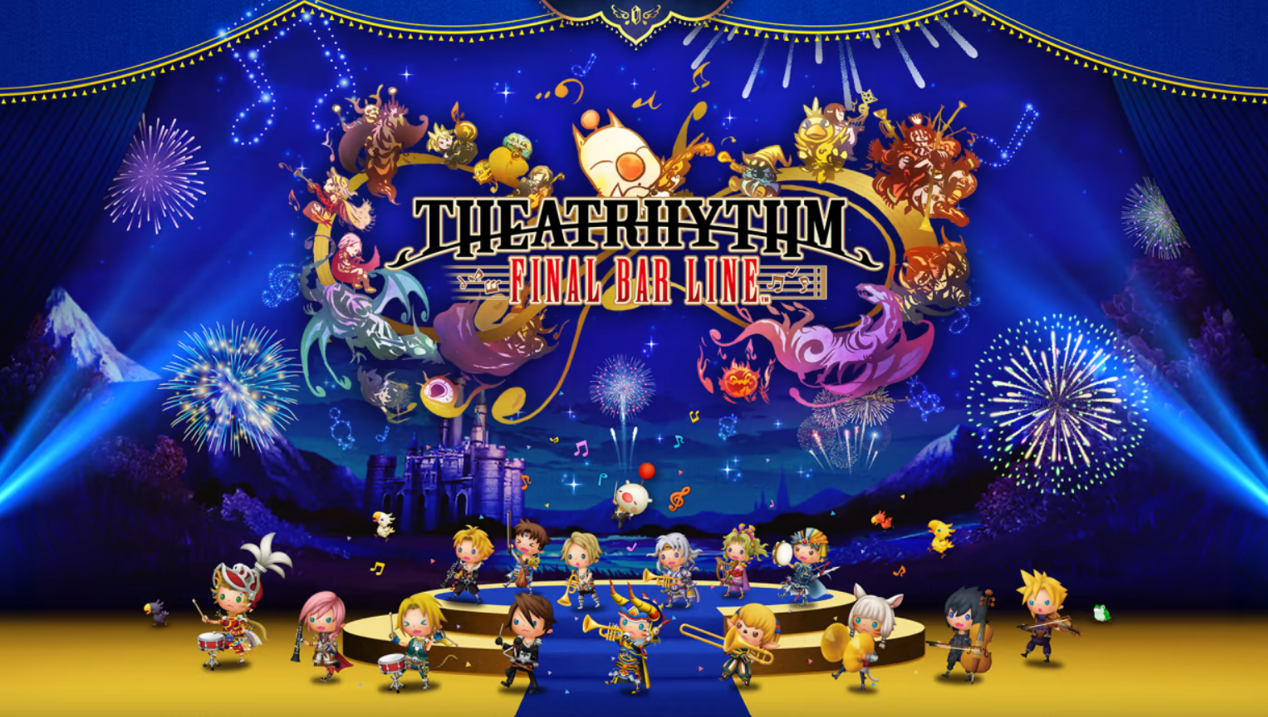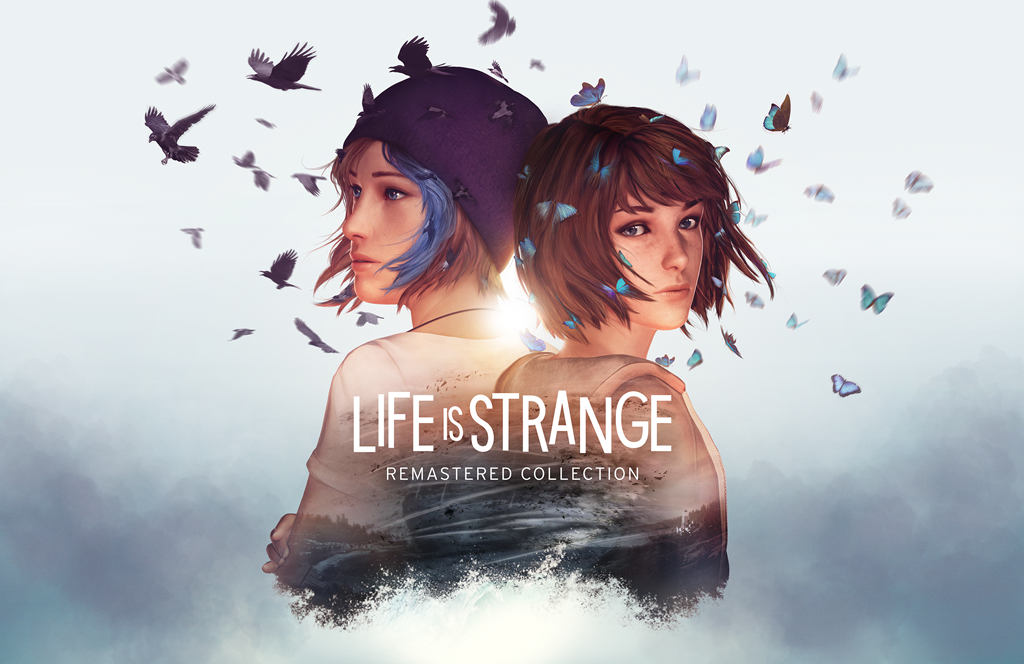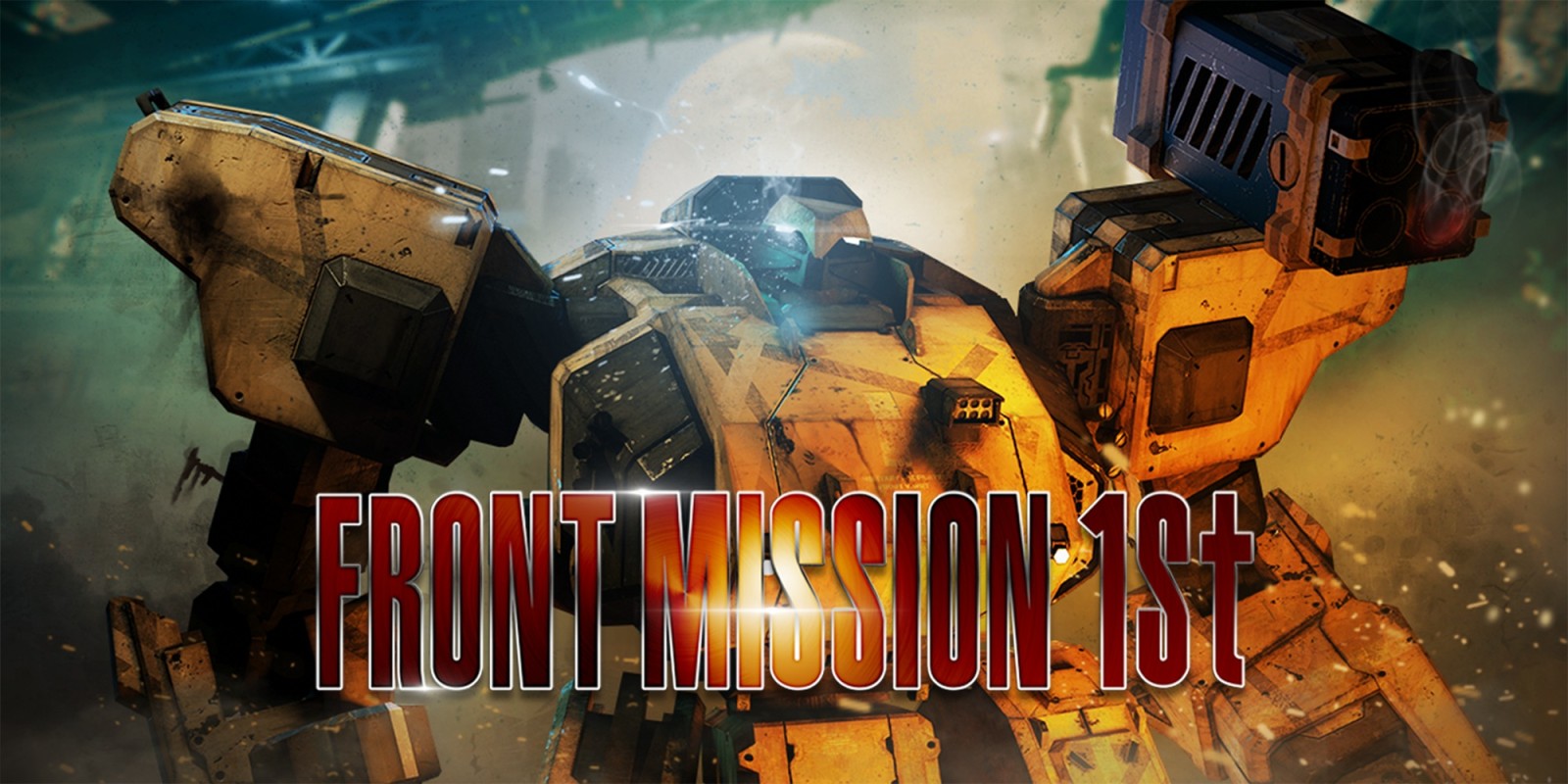Theatrhythm Final Bar Line Review (PS4) – Melodies of Life
The music of Theatrhythm Final Bar Line, and by extension of Square’s Final Fantasy series, is legendary. It is, without doubt, some of the most memorable, evocative and heart-string plucking composing of the modern era. We cover it, we study to it, we play it, we go to Distant Worlds concerts – every Final Fantasy fan has their favourites – Aerith’s theme, Shuffle or Boogie, maybe even Good King Moggle Mog XII. My personal claim on this music – it has been the always-inspiring soundtrack to my writing and life for over 25 years now, and even in 2022, Nobuo Uematsu featured as a top 5 played artist on my Spotify Wrapped.
So you know I’m coming at this from a place of love for the music. However I am 100% fresh when it comes to Theatrhythm – I have not played any prior entry and will not be able to compare them to this one in any meaningful way. If you are, like me, a series newcomer, but a Uematsu and Final Fantasy veteran, this is the place for you. Theatrhythm is a collection of literally hundreds of Final Fantasy compositions, fleshed into rhythm game button prompts, and folded again into a reward-centred real-time rhythm battler.
Theatrhythm Final Bar Line does something kind of amazing, but maybe somewhat expected. It’s a simple but accomplished rhythm game, but where it aims higher is to hit that nostalgia gland with a sledgehammer. A celebration of 35 years of game music made into a fully-fledged game all its own. So does it hit all the right notes, or does it fall flat?
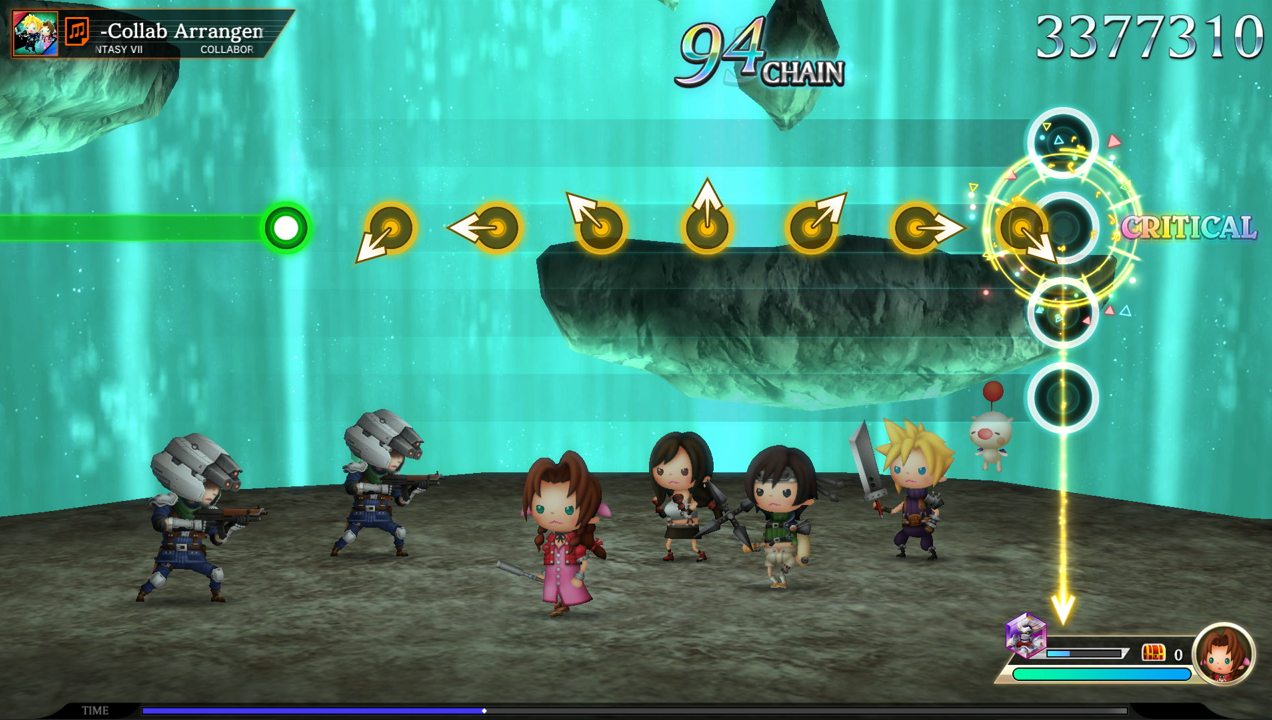
Find Your Way – FFVIII
So in most reviews we’d start with the story, but in Theatrhythm Final Bar Line there’s both no story, and dozens of them all at once. The actual game has no story. You create parties of famous characters from almost every past Final Fantasy you can think of, jumble them all up and take them into music stages, and try to reach the end with your button rhythm skills. The little avatars will fight based on how successful your input is – so if you get a perfect hit, they might cast a Blizzard attack, or slash with their sword. If you miss completely, they get hit by the enemy monsters.
Every stage is this constant battling along the bottom of the screen while you concentrate on the button prompts to get your team through it. However there’s no real storyline to your party, or anything you are doing – it’s simply a game menu structure, and stages to challenge your skills.
I also said there were dozens of stories. So each of the mainline, and many of the side-line entries in the Final Fantasy series, have a ‘Series Quest’ mode – where you fight in the battles I’ve described, but while following the basic structure of one of the games. For Final Fantasy VII that means starting with Opening-Bombing Mission, working through the game, and ending with fighting Sephiroth to the tune of One-Winged Angel. You re-live the famous series’ stories and scenes through these Series quests, and this is the equivalent of a story mode.
The second mode is simply music stages on their own, without the overarching series challenge. Across both modes there are numerous mechanics, structures, items, rewards, and such going on (probably way more than I can fit in this review), but I will try to give a flavour of the basics.
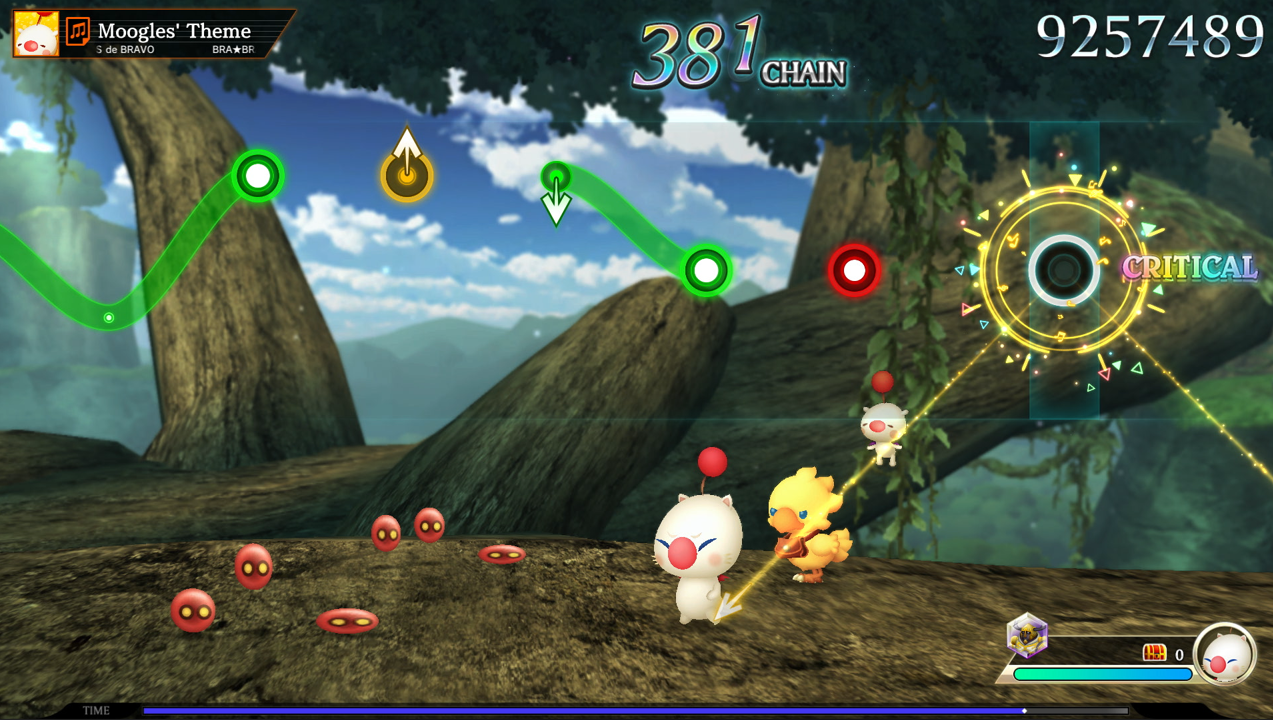
Movement in Green – FFX
Let’s start with the music and how to actually play. The music you play and fight through is split into two main types, and one sub. BMS is Battle Music Stage, and FMS is Field Music Stage – they work largely the same way, but FMS stages have a few added quirks. Button prompts slide in from the left-hand side of the screen and hit the time bar on the right – this is your moment to press that button. There are four staves, but you can just hit buttons across all of them equally so this doesn’t change difficulty, but it allows for multiple buttons at the same time.
Thankfully the controls are relatively simple. The face buttons and shoulder triggers will work for any red or green prompt coming at you. You can decide which fits your hand and skill best, then stick with it. The yellow prompts are directions and need a flick of the left joystick at the correct moment and in the correct direction. Things get tricky when you have to double up and press two at once, and I found this was best achieved on the shoulder triggers. Greens for example will often be held down notes, and this leaves your thumb free for others that might still come up.
Field Stages with their beautiful melodic overworld or town music then come with an interesting addition. On some screenshots, you’ll see the swooping green held notes making waveforms over the action. These are held notes but also require directional control as you hold, moving the joystick to match the waveform. I initially tried to flick and coax the stick to stay with the wave and failed abysmally. Instead it’s about pressing simply up or down at the moment the wave changes – with practice these can actually become the easiest things to rack up points on, rather than the hardest.
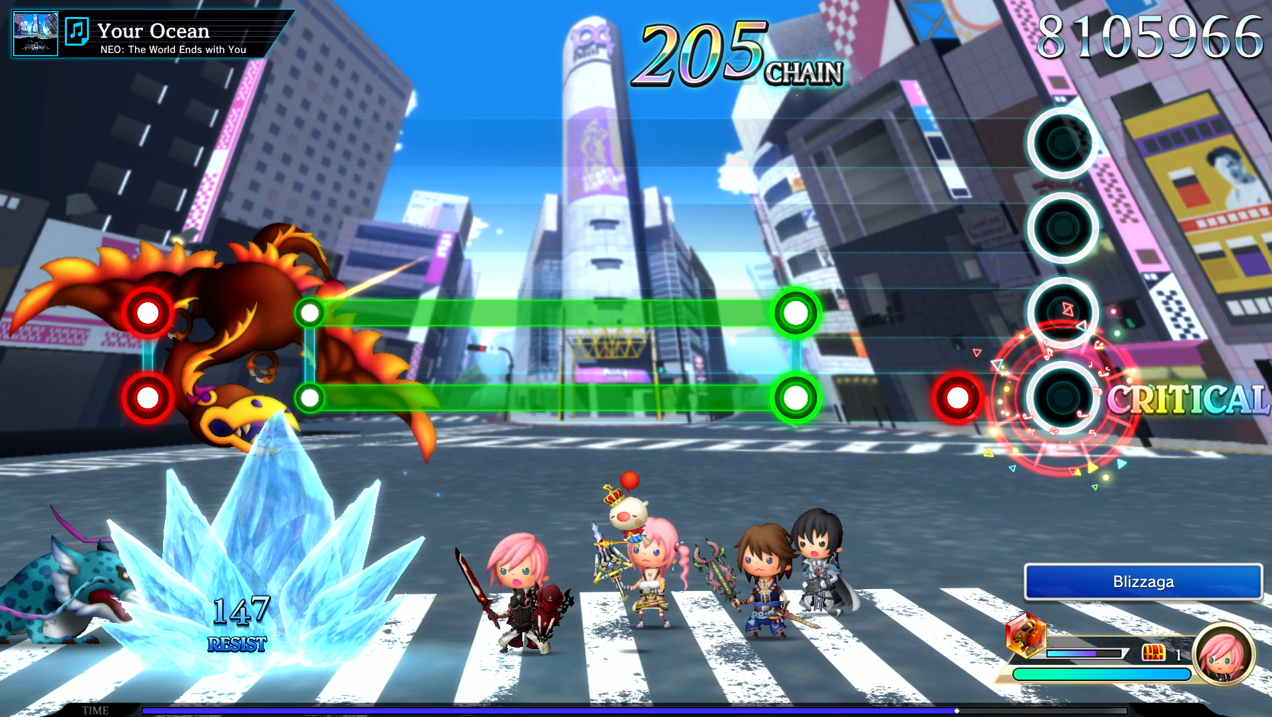
Each song has 3-4 difficulties out of 4 total – Basic, Expert, Ultimate, and Supreme. The difficulty here really comes when you have to do things simultaneously, like a direction prompt while holding down another note, or sliding down octaves at the right time and swapping buttons as you go. It’s easy enough for anyone to play most of the songs on Basic, and the game even has one-button modes where everything but timing is removed. However, Series quests and earning much of the later content requires you to up your game and start completing songs at Expert and even Ultimate difficulty.
At the end of a Series Quest, you earn a sweet one-off EMS or Event Music Stage – the screen plays an FMV montage of memorable moments from the game, and everything prompt-wise is flipped to a horizontal scroll. The controls are the same, but it can be jarring to suddenly need to do things Guitar Hero style instead of left-to-right. These scenes do highlight my first issue with the game.
There’s a hell of a lot going on – while I’m keeping up with the song, I’m not able to concentrate on the beautiful montages, little sprite battles, or whether they are losing health or killing enemies. The moment I look away from what I’m doing, I miss chunks of the song. Without these other elements, it would be dull to watch, but they also aren’t really for the player at that instant. These things are for your mate, your significant other, or that stranger online viewing your stream, to give them something to watch.

Let the Battles Begin! – FFVII
So there’s all this other stuff happening while you are concentrating on button presses. Your team of creepy little Final Fantasy character sprites are having a battle, facing off against hordes of enemies and your skills mean success or failure for them. But there’s lots to be done to help them survive. Every character has stats (HP and Strength and such) and can level up based on the EXP earned at the end of each song. The more HP, the longer they’ll last at moments when you mess up. They also have skills or magic powers they can deploy.
For example Squall from FF8 is an attack type, and Vanille from FF13 is a Healer. Squall might be damaging enemies as you successfully complete the song, but Vanille will be healing your team, which might be even more important if it’s a hard song or a high difficulty. Some have elemental attacks, so you can employ your Final Fantasy knowledge built up over multiple games and if you’re facing Ifrit, bring along some Ice magic users to make taking him out more effective.
Songs also have quests and challenges attached to them. Try to reach and kill certain bosses or enemies, or use certain party members or skills. You’ve only got the button presses to play with, so these things are dependent on how well you do. For example, in an early FF7 song the quest is to defeat the Scorpion Boss, but you can easily complete that level without reaching said Scorpion. Your level, the difficulty played and the party members, will all factor into how many enemies you get through during the 2-3 minute song. The Scorpion is a high-difficulty enemy at the end of many others, so you need to be high level, and particularly good at the rhythm part to rinse through the earlier enemies, reach the boss, and then also kill them.
Completing quests and songs – doing anything really – will bag you drops, loot, and rewards. Theatrhythm Final Bar Line throws shiny cards, items, levels, EXP, more songs, more characters at you constantly, anything it can to flick that dopamine pulse and keep you playing. And it really works, like scarily well. On my first session I lost 3 hours without even realising it, so absorbed was I in the reward/challenge cycle that was coming at me from all sides.
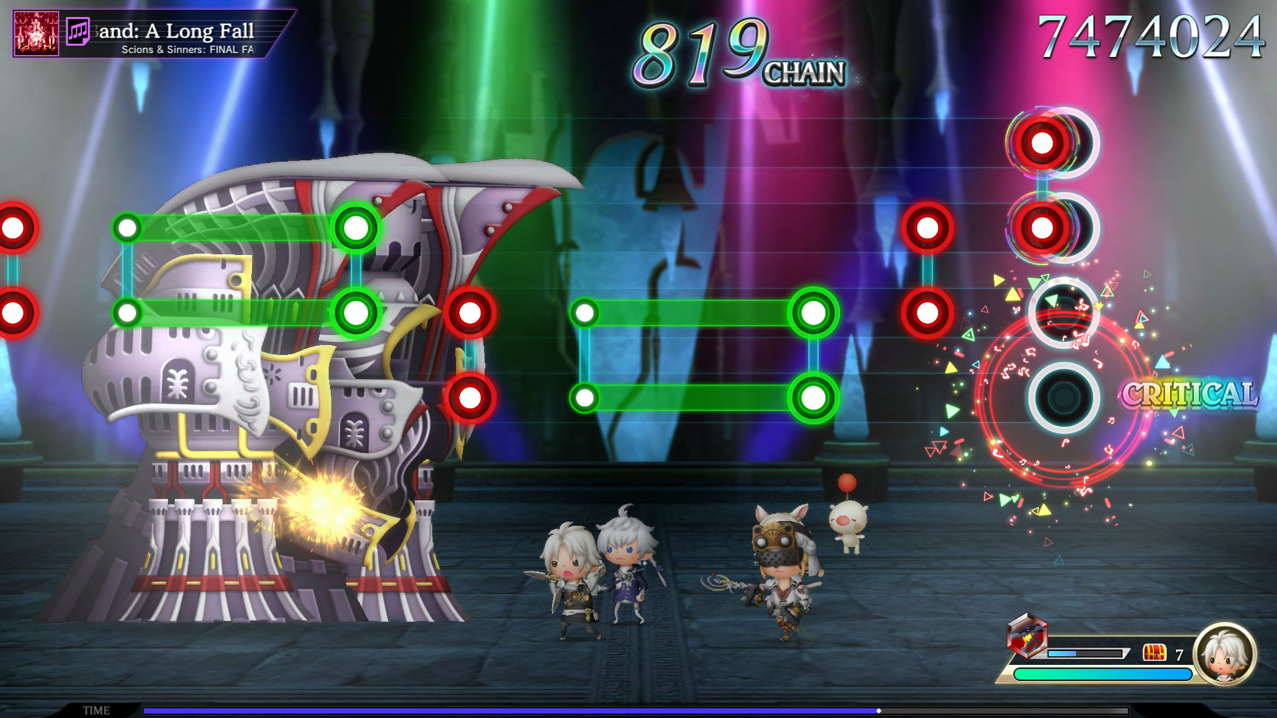
Melodies Errant – FFXI
That’s also reflected in the sheer amount of content – there are 380 or so songs in the base game alone, across at least 20 games, and maybe a hundred remixes and alternate arrangements. Then there’s more in the Digital Deluxe edition, and 90+ songs of DLC planned across other Square Enix IP like Neir, SaGa, Octopath etc if you shell out for the Premium version or the Season Pass. There are hundreds of characters to earn, cards to find, rewards to be collected, and trophies to attempt. Replayability is high as the music is timeless and the challenges go on seemingly forever.
I feel the sheer amount of it may be why resources were not so equally spent on graphics. Where Theatrhythm perhaps fails to impress most in its sprites and graphical work. The game itself looks nice enough, and everything is recognisable as what it’s meant to be in the FF Universe. But I found the sprites were also creepy, with a strange dead-behind-the-eyes look. The enemy artwork left much to be desired, verging on ugly. I don’t see why everything couldn’t have been cuter, chibi-styled things like in World of Final Fantasy, or even beautiful pixelart. We know Square Enix has the artistic talent.
Maybe that’s also time to talk of the strange omissions. With 380+ tracks you’d think they’d covered everything, and to any layman that’s probably true. But surely the target market is FF veterans like me? I’ve played every single game in this series. So I find it strange that there aren’t more of the deep-cut type tracks. There’s a number of fan favourite FF7 tracks missing, such as Oppressed People, or You Can Hear the Cry of the Planet. There’s a couple of completely forgotten games – FF Tactics Advance and FFXII Revenant Wings. Wings was a direct storyline sequel to FFXII set in Ivalice, and it was a wonderful DS game and had at least a handful of worthwhile tracks. If all three FFXIII games get in, and X-2, why not Revenant Wings? It’s also strange to see Brave Exvius snubbed when Mobius is included. And no sign of Vagrant Story in the DLC, when that’s also set in Ivalice.
I would normally do a few paragraphs on sound and music in any other game, but it seems somewhat redundant in a rhythm release. It’s all I’ve been talking about. I will take this moment to counter the last point, with a shout out to a few of the incredible composers who work for Square Enix, and the incredible inclusions in this release – Nobuo Uematsu, Masashi Hamauzu and Hitoshi Sakimoto primarily as the main contributors. There are also dozens of Theatrhythm-specific tributes, the Black Mages gets a couple of tracks in, Yoko Tarro of Neir fame in the DLC. Favourite tracks had to be the uplifting ones Ride On (FFVIII), Dugem de Chocobo (which is a remixed version of a bunch of the Chocobo themes), Aboard the Hildagarde… argh, too many to list.
Lastly I’ll cover multiplayer. There is a multiplayer mode, but it just kind of is – it’s not interesting or memorable really. Structured as 4 single players against each other, it tasks you with getting a better score on the same song, being played simultaneously by the other three challengers online. The good parts are that magic you cast gets thrown at the other players, hiding their button prompts and such, and it’s nice that the game tells you who’s ahead as you go. I didn’t like that you can’t see your opponents or their success, and that the structure just constantly bled into the next song, without any real end result or tournament. It’s more like its own endless mode. There’s no match-making, so choose your opponents carefully in the lobby, the rating is how much they’ve been winning online, so when you start out choose low ones.
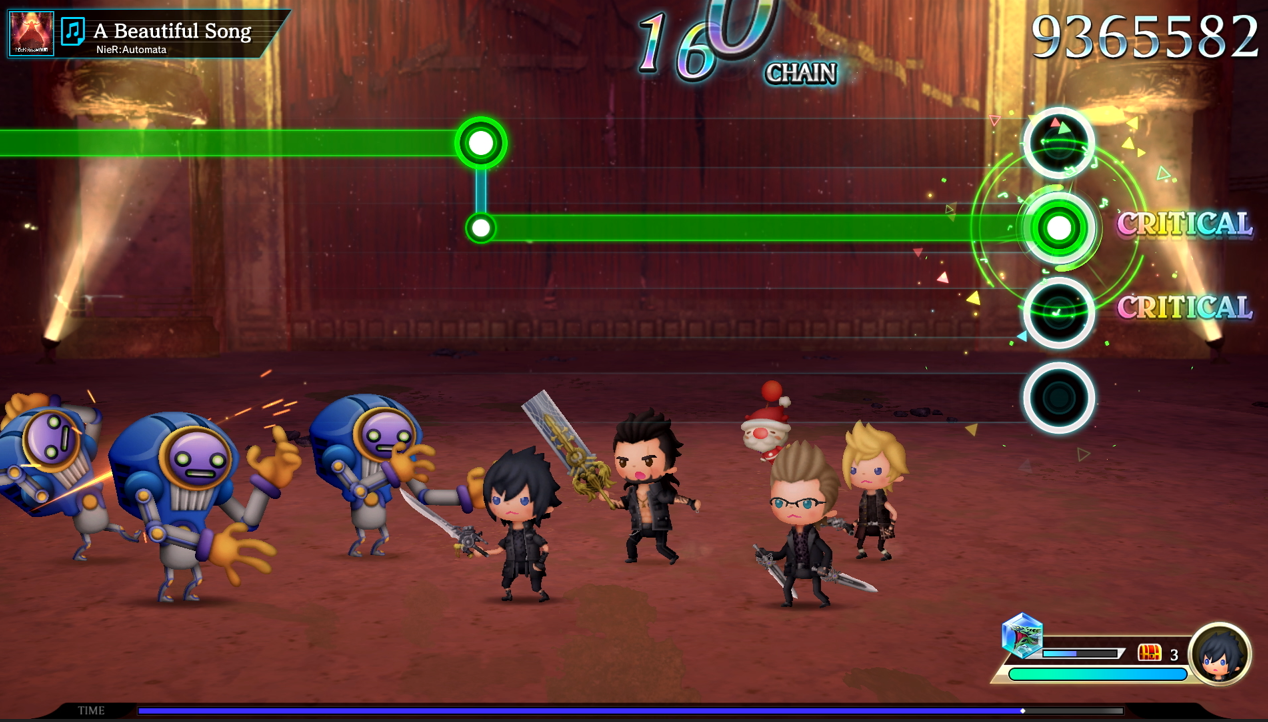
Curtain Call – Special Arrangement Medley
Listening to music is a passive medium, playing it is creation. Rhythm games let you interact and create in a kind of middle ground between playing, listening and dancing. This is what makes Tetris Effect Connected, Guitar Hero, and Rez so special. Theatrhythm Final Bar Line makes a play for this encompassing musical experience, smashing it together with your nostalgic memories of some of the greatest RPGs ever made. Square Enix has possibly the greatest composing house in all of gaming and this is also something only some of the absolute biggest publishers could ever do – almost no other series comes close to the fan reaction and love of the music. Hats off to them.
There’ll be those disparaging the 90+ Season pass songs, but I cannot fault the 380 already included in the base game – Square Enix has outdone themselves. They could have had half that and it would still have been a huge release. And if all you really want is Final Fantasy rather than the other IPs you’ve got everything you need in the Deluxe Edition.
The best thing about Theatrhythm Final Bar Line is getting to relive the nostalgia of your gaming youth, getting to interact and play through your favourite tracks. You’ve got endorphins from the challenge and reward firing off everywhere, and the dopamine snare-hit every time you hit those sweet Perfect Combos. It’s a heady brew that makes Theatrhythm one of those just-one-more-go kinds of games, until you suddenly realise you’ve missed work or stayed up all night.
A brilliant duet of simple-to-play, tough-to-master rhythm game, mixed with a snare-hit of nostalgia right to the face. Theatrhythm Final Bar Line is both a beautiful collection of incredible music and a fun battler that rewards your rhythm skills with satisfying progression.

Theatrhythm Final Bar Line is out now on PlayStation 4 (review platform) and Nintendo Switch.
Developers: indieszero
Publishers: Square Enix
Disclaimer: In order to complete this review, we were provided with a promotional code from the publisher. For our full review policy, please go here.
If you enjoyed this article or any more of our content, please consider our Patreon.
Make sure to follow Finger Guns on our social channels. Twitter, Facebook, Twitch, Spotify or Apple Podcasts – to keep up to date on our news, reviews and features.
